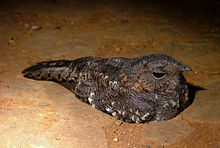Tschudi's nightjar
| Tschudi's nightjar | |
|---|---|

| |
| Band-winged Nightjar (Caprimulgus longirostris) | |
| Scientific classification | |
| Domain: | Eukaryota |
| Kingdom: | Animalia |
| Phylum: | Chordata |
| Class: | Aves |
| Clade: | Strisores |
| Order: | Caprimulgiformes |
| Family: | Caprimulgidae |
| Genus: | Systellura |
| Species: | S. decussata
|
| Binomial name | |
| Systellura decussata (Tschudi, 1844)
| |

| |
| Synonyms | |
| |
Tschudi's nightjar or lesser band-winged nightjar (Systellura decussata) is a species of nightjar in the family Caprimulgidae. It is found in Chile and Peru.[2]
Taxonomy and systematics
Tschudi's nightjar was originally considered a species, then a subspecies of band-winged nightjar (Systellura longirostris), and since 2016 again is treated as a species. It also was assigned for a time to genus Caprimulgus. Its current position in genus Systella is not completely resolved; it shares the genus with the band-winged nightjar but does not seem to be closely related to it. It is monotypic.[3][4][2]
Description
Tschudi's nightjar is 20 to 21 cm (7.9 to 8.3 in) long. Males weigh 28.5 to 35 g (1.0 to 1.2 oz) and females about 32 g (1.1 oz). It is overall grayish brown with blackish speckles. The male has a broad tawny or cinnamon collar on the hindneck, a small white patch on the throat, white bands on the wing, and white bands and tips on the tail. The female's throat is buff, the bands on the wing are buff, and the tail usually has no white.[4]
Distribution and habitat
Tschudi's nightjar is found along most of western Peru and extreme northern Chile. It inhabits the littoral and foothills in this arid landscape. It generally keeps to open country, clearings, and wooded edges though it is also found in urban areas including Lima, Peru. In Peru it ranges from sea level to 1,300 m (4,300 ft) but has been reported as high as 3,350 m (11,000 ft) in Chile.[4]
Behavior
Feeding
Nothing is known about Tschudi's nightjar's diet or feeding behavior.[4]
Breeding
The breeding season of Tschudi's nightjar is thought to be from November or earlier to January. Essentially nothing else is known about its breeding phenology.[4]
Vocalization
Tschudi's nightjar's song is "a loud series of well-defined, but slightly buzzy 'cueeo' notes". Its alarm call is "a slightly squeaky-sounding 'wick'".[4]
Status
The IUCN has assessed Tschudi's nightjar as being of Least Concern. It has a range estimated to be at least 200,000 km2 (77,000 sq mi), and though its population has not been quantified it is thought to be stable.[1][4]
References
- ^ a b BirdLife International (2016). "Tschudi's Nightjar Systellura decussata". IUCN Red List of Threatened Species. 2016. Retrieved 9 October 2021.
- ^ a b Gill, F.; Donsker, D.; Rasmussen, P. (July 2021). "IOC World Bird List (v 11.2)". Retrieved July 14, 2021.
- ^ Remsen, J. V., Jr., J. I. Areta, E. Bonaccorso, S. Claramunt, A. Jaramillo, D. F. Lane, J. F. Pacheco, M. B. Robbins, F. G. Stiles, and K. J. Zimmer. Version 24 August 2021. A classification of the bird species of South America. American Ornithological Society. https://www.museum.lsu.edu/~Remsen/SACCBaseline.htm retrieved August 24, 2021
- ^ a b c d e f g del Hoyo, J., N. Collar, and G. M. Kirwan (2020). Tschudi's Nightjar (Systellura decussata), version 1.0. In Birds of the World (J. del Hoyo, A. Elliott, J. Sargatal, D. A. Christie, and E. de Juana, Editors). Cornell Lab of Ornithology, Ithaca, NY, USA. https://doi.org/10.2173/bow.bawnig3.01 retrieved October 9, 2021
- Cite IUCN without doi
- Articles with short description
- Short description matches Wikidata
- Use American English from October 2021
- All Wikipedia articles written in American English
- IUCN Red List least concern species
- Articles with 'species' microformats
- Taxonbars with automatically added original combinations
- Nightjars
- Systellura
- Birds of Peru
- Birds of Chile
- Birds described in 1844

